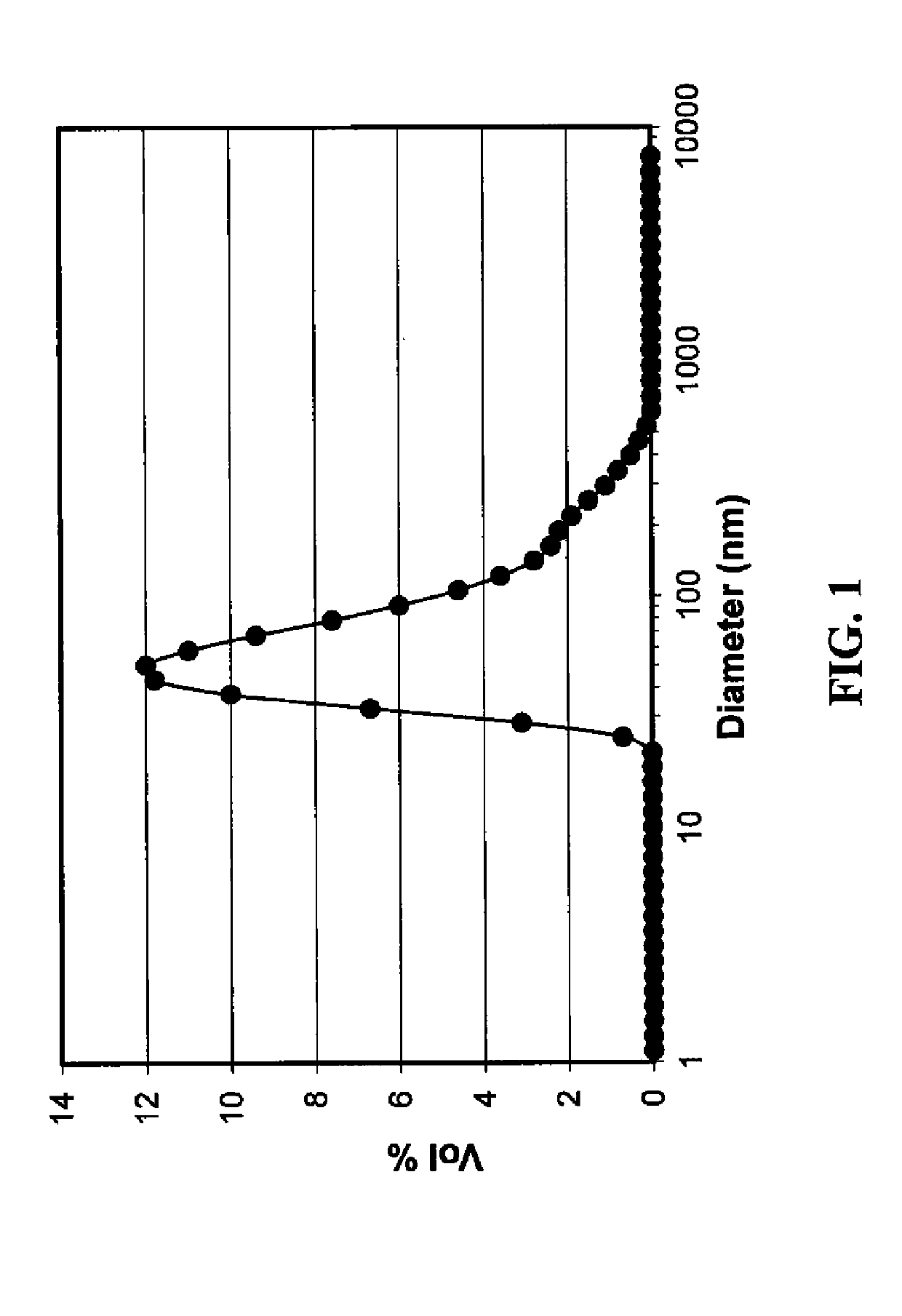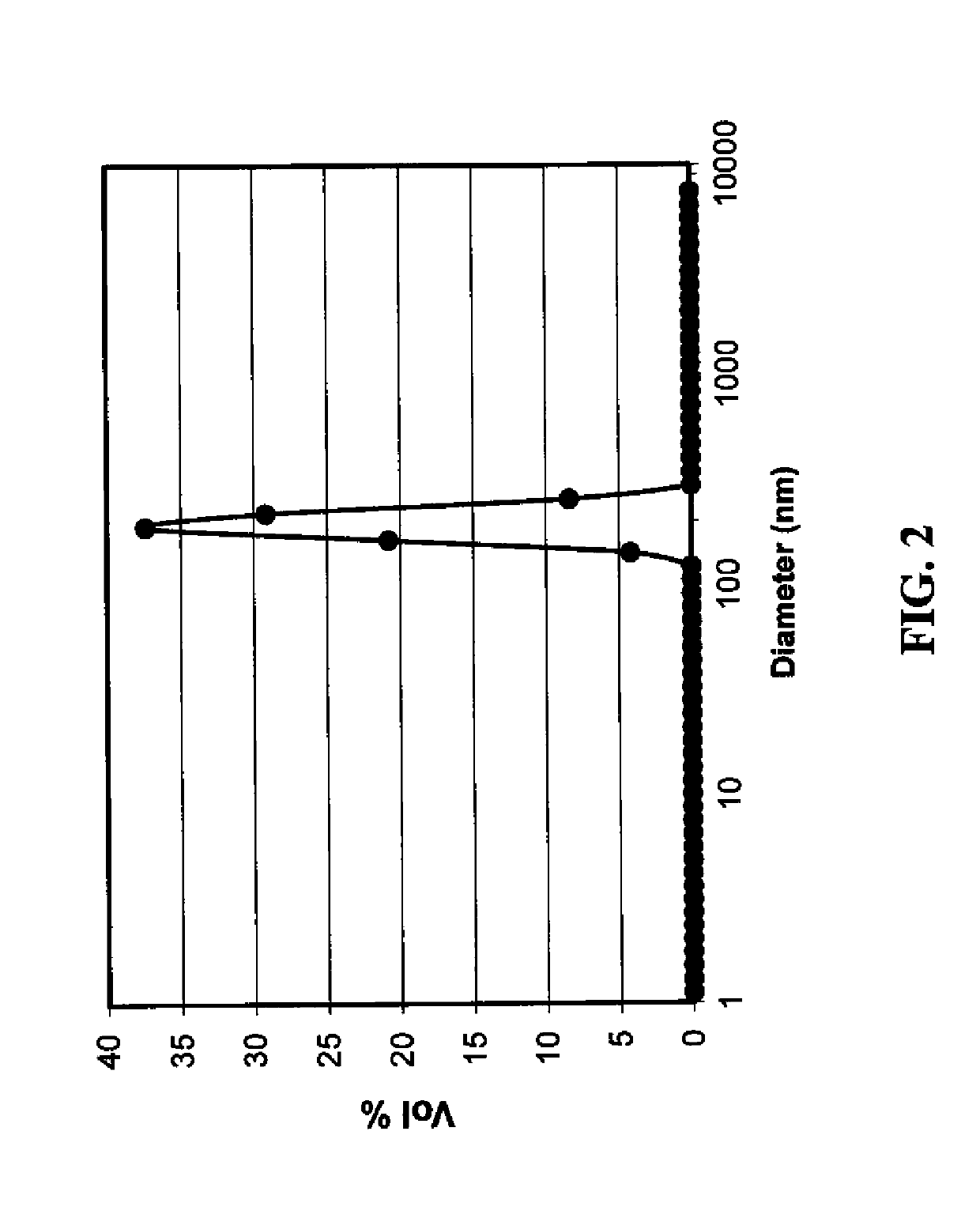Method of making silver-containing dispersions with nitrogenous bases
a technology of nitrogenous bases and nanoparticles, which is applied in the field of forming a silver nanoparticle composite, can solve the problems of incompatible ink with many polymeric and paper substrates, time-consuming and expensive photolithographic and electroless techniques, and inability to microfabricate electrically-conductive tracks (grids, wires, patterns) , to achieve the effect of reducing the cost of manufacturing and manufacturing
- Summary
- Abstract
- Description
- Claims
- Application Information
AI Technical Summary
Benefits of technology
Problems solved by technology
Method used
Image
Examples
invention example 1
Aqueous Dispersion Containing Silver Nanoparticle-Cellulose Acetate Composite Using 2-Butyl Aminoethanol as the Nitrogenous Base
[0229]In a 2-necked round bottomed flask a mixture of cellulose acetate (0.375 g; Aldrich, mol.wt. of 50,000, acetyl content of 39%) and 2-butyl aminoethanol (0.9 g) in 2-methoxyethanol (8 ml) was heated at 95° C. with stirring until all cellulose acetate was dissolved to form a premix solution. A solution of silver nitrate (5 g) dissolved in 2-methoxyethanol (15 ml) was slowly added to form a reaction mixture over a period of 20 minutes. During this addition, the reaction mixture became dark grey in color. It was stirred at 95° C. for another 30 minutes, cooled, and poured into methanol (500 ml). The resulting precipitate (silver nanoparticle-cellulose acetate composite) was filtered and washed with methanol to yield a gray solid (yield 98% based on theoretical silver).
[0230]Particle size distribution was measured using a dynamic light scattering method (M...
invention example 2
Aqueous Dispersion Containing Silver Nanoparticle-Cellulose Acetate Propionate Composite Using 2-Methyl Aminoethanol as the Nitrogenous Base
[0233]In a 2-necked round bottomed flask. a mixture of cellulose acetate propionate (0.18 g; Eastman CAP 482-0.5, propionyl content 43%, Acetyl content 0.6%, mol. wt. of 25,000) and 2-methyl aminoethanol (1.5 g, mmol) in 2-methoxyethanol (7 ml) was heated at 95° C. with stirring until all cellulose acetate propionate was dissolved to form a premix solution. A solution of silver nitrate (5 g) dissolved in 2-methoxyethanol (15 ml) was added to the premix solution over a period of 35 minutes. The resulting reaction mixture was stirred at 95° C. for another 45 minutes, cooled, and poured into water (400 ml). The resulting precipitate was filtered and washed with methanol. A grey colored solid was obtained (yield of 97% based on silver). Particle size distribution was measured using a dynamic light scattering method (Malvern Instruments Ltd. Zetasize...
invention example 3
Aqueous Dispersion of Silver Nanoparticle-Cellulose Acetate Propionate Composite Using 1,8-Diazabicyclo[5.4.0]undec-7-ene as the Nitrogenous Base
[0235]In a 2-necked round bottomed flask, a mixture of cellulose acetate propionate (0.4 g; Eastman CAP 482-20, propionyl content 48%, Acetyl content 1.3%, Mol. wt. of 75,000) and 1,8-diazabicyclo[5.4.0]undec-7-ene (16 g, mmol) in 2-methoxyethanol (28 ml) was heated at 95° C. with stirring until all cellulose acetate propionate was dissolved to form a premix solution. A solution of silver nitrate (8.8 g) dissolved in 2-methoxyethanol (100 ml) was added to the premix solution over a period of 80 minutes. The resulting reaction mixture was stirred at 95° C. for another 20 minutes, cooled, and poured into water (800 ml). The resulting precipitate was filtered and washed with methanol. A grey colored solid was obtained (yield of 98% based on silver). Particle size distribution was measured a dynamic light scattering method (Malvern Instruments ...
PUM
| Property | Measurement | Unit |
|---|---|---|
| Temperature | aaaaa | aaaaa |
| Temperature | aaaaa | aaaaa |
| Temperature | aaaaa | aaaaa |
Abstract
Description
Claims
Application Information
 Login to View More
Login to View More - R&D
- Intellectual Property
- Life Sciences
- Materials
- Tech Scout
- Unparalleled Data Quality
- Higher Quality Content
- 60% Fewer Hallucinations
Browse by: Latest US Patents, China's latest patents, Technical Efficacy Thesaurus, Application Domain, Technology Topic, Popular Technical Reports.
© 2025 PatSnap. All rights reserved.Legal|Privacy policy|Modern Slavery Act Transparency Statement|Sitemap|About US| Contact US: help@patsnap.com



